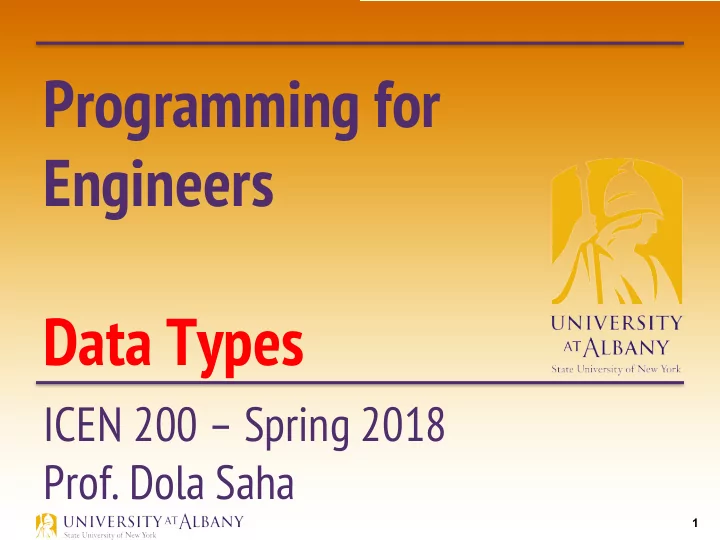

Programming for Engineers Data Types ICEN 200 – Spring 2018 Prof. Dola Saha 1
Data Types Data Type Description Bytes in Memory Character 1 char Whole number 4 or 2 (natural size of integer in int host machine) Real number - Single precision floating point Usually 4 float Real number - Double precision floating point Usually 8 double Shorter than regular Usually 2 short Longer than regular Usually 8 long No bits used for sign unsigned 1 bit used for sign signed 2
Numeric Data Types 3
Data type: char Ø 1 Byte or 8 bits Ø Example: A, c, x, q Ø Character is represented in memory as a binary number Ø Value stored is determined by ASCII (American Standard Code for Information Interchange) code. Ø Print format: %c Ø If printed with %d § Prints the value in ASCII 4
Character and ASCII 5
Data type: int Ø Standard Integer Ø Limited by size of memory Ø Usually 4 bytes Ø Value stored in binary Ø 1 bit for sign (0 for positive, 1 for negative) Ø Range: -2147483648, 2147483647 Ø Print format: %d Ø Use unsigned to use all the bits 6
Integer will not suffice – real applications Ø Calculate area of a circle 42.686908, -73.823919 Ø Calculate average of grades in class 7
Float, Double Ø Real number, analogous to scientific notation Ø Storage area divided into three areas: § Sign (0 for positive, 1 for negative) § Exponent (repeated multiplication) § Mantissa (binary fraction between 0.5 and 1) type double format sign exponent mantissa Ø The mantissa and exponent are chosen such that the following formula is correct real number � mantissa � 2 exponent or storage of a type number, th 8
Float, Double Ø Float (single precision) § 1 bit sign, 8 bits exponent, 23 bits mantissa Ø Double (double precision) § 1 bit sign, 11 bits exponent, 52 bits mantissa Ø Depends on hardware Ø Print format: %f (for float) %lf (for double) 9
Short, Long, Long Double Ø Short § Usually 2 bytes whole number § Print format: %d Ø Long § Usually 8 bytes whole number § Print format: %ld Ø Long Double § Usually 16 bytes fractional § Print format: %Lf 10
Size and limits 11
Output of size 12
Ranges Whole Number Type Range in Typical Microprocessor Implementation short − 32,767 .. 32,767 unsigned short 0 .. 65,535 int − 2,147,483,647 .. 2,147,483,647 unsigned 0 .. 4,294,967,295 long − 2,147,483,647 .. 2,147,483,647 unsigned long 0 .. 4,294,967,295 Real Number Type Approximate Range* Significant Digits* float 10 − 37 .. 10 38 6 double 10 − 307 .. 10 308 15 long double 10 − 4931 .. 10 4932 19 *In a typical microprocessor-based C implementation 13
Review Questions Ø State True or False: § Short takes more memory space than Integer (int) § Float and double are real number representations in C § Char is represented in memory by ASCII § Print format for char is %d § Print format for double is %lf § Float and double has 2 parts: exponent and mantissa 14
Review Questions / Answers Ø State True or False: § Short takes more memory space than Integer (int) FALSE § Float and double are real number representations in C TRUE § Char is represented in memory by ASCII TRUE § Print format for char is %d FALSE § Print format for double is %lf TRUE § Float and double has 2 parts: exponent and mantissa FALSE 15
What is the error in code? 16
What is the error in code? Compilation Error Correct Code 17
What is the error in code? 18
What is the error in code? Compilation Error Correct Code 19
What is the error in code? Ø Ddad 20
What is the error in code? Ø Ddad Compilation Error Correct Code 21
Common Errors Omitting the parentheses after main. Ø Omitting or incorrectly typing the opening brace { that signifies the start of a Ø function body. Omitting or incorrectly typing the closing brace } that signifies the end of a Ø function. Misspelling the name of a function; for example, typing pintf ( ) instead of Ø printf ( ). Forgetting to close the message to printf ( ) with a double quote symbol. Ø Omitting the semicolon at the end of each C statement. Ø Adding a semicolon at the end of the #include preprocessor command. Ø Forgetting the \n to indicate a new line. Ø Incorrectly typing the letter 0 for the number zero (0), or vice versa. Ø Incorrectly typing the letter I for the number 1, or vice versa. Ø 22
C Keywords Ø Reserved words of the language, special meaning to C compiler Ø Do not use these as identifiers, like variable names 23
Recommend
More recommend